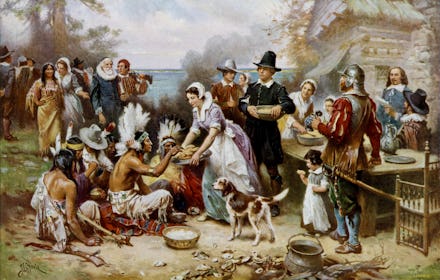The Biggest Lies We Teach American Kids About Thanksgiving and Native Americans

Almost 400 years ago, a group of religious separatists from Plymouth, England, arrived in the "New World" on a ship called the Mayflower. The Native Americans these Pilgrims encountered took pity on them and taught them how to plant crops, the successful cultivation of which they all later celebrated by sharing a beautiful feast.
This is the origin story of the American tradition of Thanksgiving, according to the History Channel. Or at least it's the story many children across the country still learn about Thanksgiving. The truth, many historians have noted, is quite different from this myth and paints a far less benevolent picture of the colonist-Native American relationship.
Myth No. 1: Pilgrims and Native Americans were great, fast friends.
The Native American Mashpee Wampanoag tribe didn't benevolently befriend and support the British interlopers. In fact, "there's no evidence that there were good relations at all," between the two groups, Roxanne Dunbar-Ortiz, author of An Indigenous Peoples' History of the United States, told Mic. Also, because of their religious backgrounds, the likelihood Pilgrims would have participated in a celebratory feast of any nature is low.
Pilgrims were "religious fanatics," who, as such, "were not feasters, they were fasters," Dunbar-Ortiz said. This religion encouraged Pilgrims to believe "indigenous people [were] devils" and their ultimate intention, therefore, was to "clear the area of the native people and take their farmlands" as "a prelude to the colonization of the entire continent" — which, Dunbar-Ortiz noted, is exactly what they did.
Myth No. 2: The first Thanksgiving celebrated a harvest born from this friendship.
Not only did the first Thanksgiving hardly celebrate a successful harvest or budding alliance, but it also was actually a valorization of a bloody conquest, author Richard Greener wrote in the Huffington Post. After returning from what is now Mystic, Connecticut, "a band of heavily armed hunters" were celebrated by their Pilgrim peers for massacring 700 Pequot Indians, according to Greener.
The Mashpee Wampanoag tribe heard this celebration, which included celebratory shooting of guns and canons, Peters said. The tribe decided to respond to what they perceived as a potential threat by gathering 90 warriors who were "prepared to engage" should they find the Pilgrims were preparing to fight. "It was a fact-finding mission," Peters said. After learning the Pilgrims were celebrating, and not threatening them, the tribe members still only stayed for the meal to "make sure that was true."
Myth No. 3: Native Americans now ignore this history.
Every year, hundreds of people travel to Cole's Hill in Plymouth, Massachusetts, to honor Native Americans who died at the hands of colonists. Specifically, they're paying respects to the 700 Native American men, women and children massacred on the day of Thanksgiving itself, Boston.com reported in 2014. The National Day of Mourning was founded by former Wampanoag leader Wamsutta Frank James, who in 1970 was rejected from speaking at the 350th anniversary of the Pilgrims' landing after the event's organizers learned about what he would be speaking, according to the same report.
"It was a holocaust, and that holocaust must be shared and communicated so that we ensure that mankind doesn't do that to each other again," Cedric Cromwell, chairman and president of the tribal council of the Mashpee Wampanoag, recently told the Huffington Post about the importance of commemorating the day. "We know this world is made up of travesty and tragedy. We also know that this world is made of a lot of goodness and hope and honesty and integrity."
Myth No. 4: Thanksgiving was made a holiday as a show of goodwill toward Native Americans.
Until Abraham Lincoln officially declared Thanksgiving a national holiday, the day was celebrated sporadically and on a state-by-state basis, according to the History Channel. In fact, Lincoln only made the event an official holiday after writer Sarah Josepha Hale wrote to him in 1863, beseeching that he do so for the sake of the nation's unity — which was in a precarious state at the time due to the Civil War, according to the History Channel.
What's more, Lincoln was actualizing groundwork already laid by previous presidents: George Washington similarly called for a day to commemorate the end of the American Revolution, and John Adams and James Madison proposed similar events, according to the History Channel. Their efforts were ultimately thwarted, however, by Thomas Jefferson, who felt uncomfortable with any religious connotations given the nation's founding on the idea of a separation of church and state.
As Dunbar-Ortiz told Mic, Thanksgiving should not only no longer "be used as an origin story," but there's also "no reason why it should even be in history books." Instead, children should be taught about the horrific reality of colonization in this nation.
Not only is perpetuating myths about Thanksgiving wrong at face value, but it also contributes to the broader cultural tendency to ignore the enduring obstacles Native Americans face as a longstanding result of colonization, including high rates of poverty, police brutality and suicide. Teaching children the truth about Thanksgiving is not an act of historical accuracy, therefore, but one of modern necessity.